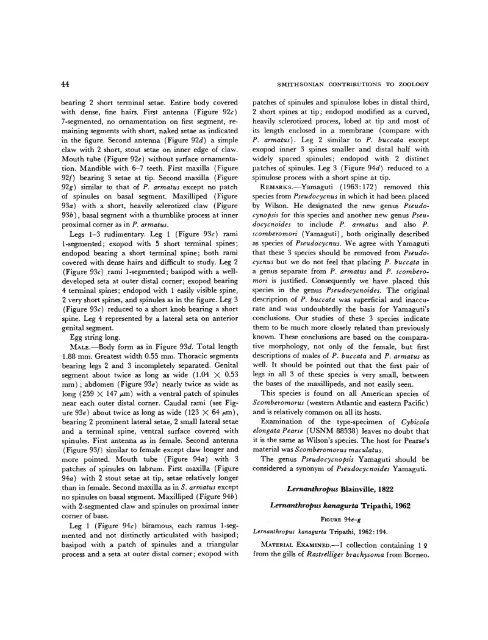Parasitic Copepods of Mackerel - and Tuna-like Fishes (Scombridae ...
Parasitic Copepods of Mackerel - and Tuna-like Fishes (Scombridae ...
Parasitic Copepods of Mackerel - and Tuna-like Fishes (Scombridae ...
Create successful ePaper yourself
Turn your PDF publications into a flip-book with our unique Google optimized e-Paper software.
44 SMITHSONIAN CONTRIBUTIONS TO ZOOLOGY<br />
bearing 2 short terminal setae. Entire body covered<br />
with dense, fine hairs. First antenna (Figure 92c)<br />
7-segmented, no ornamentation on first segment, remaining<br />
segments with short, naked setae as indicated<br />
in the figure. Second antenna (Figure 92d) a simple<br />
claw with 2 short, stout setae on inner edge <strong>of</strong> claw.<br />
Mouth tube (Figure 92e) without surface ornamentation.<br />
M<strong>and</strong>ible with 6-7 teeth. First maxilla (Figure<br />
92/) bearing 3 setae at tip. Second maxilla (Figure<br />
92g) similar to that <strong>of</strong> P. armatus except no patch<br />
<strong>of</strong> spinules on basal segment. Maxilliped (Figure<br />
93a) with a short, heavily sclerotized claw (Figure<br />
93b), basal segment with a thumb<strong>like</strong> process at inner<br />
proximal corner as in P. armatus.<br />
Legs 1-3 rudimentary. Leg 1 (Figure 93c) rami<br />
1-segmented; exopod with 5 short terminal spines;<br />
endopod bearing a short terminal spine; both rami<br />
covered with dense hairs <strong>and</strong> difficult to study. Leg 2<br />
(Figure 93c) rami 1-segmented; basipod with a welldeveloped<br />
seta at outer distal corner; exopod bearing<br />
4 terminal spines; endopod with 1 easily visible spine,<br />
2 very short spines, <strong>and</strong> spinules as in the figure. Leg 3<br />
(Figure 93c) reduced to a short knob bearing a short<br />
spine. Leg 4 represented by a lateral seta on anterior<br />
genital segment.<br />
Egg string long.<br />
MALE.—Body form as in Figure 93d. Total length<br />
1.88 mm. Greatest width 0.55 mm. Thoracic segments<br />
bearing legs 2 <strong>and</strong> 3 incompletely separated. Genital<br />
segment about twice as long as wide (1.04 X 0.53<br />
mm) ; abdomen (Figure 93e) nearly twice as wide as<br />
long (259 X 147 /xm) with a ventral patch <strong>of</strong> spinules<br />
near each outer distal corner. Caudal rami (see Figure<br />
93e) about twice as long as wide (123 X 64 fim),<br />
bearing 2 prominent lateral setae, 2 small lateral setae<br />
<strong>and</strong> a terminal spine, ventral surface covered with<br />
spinules. First antenna as in female. Second antenna<br />
(Figure 93/) similar to female except claw longer <strong>and</strong><br />
more pointed. Mouth tube (Figure 94a) with 3<br />
patches <strong>of</strong> spinules on lab rum. First maxilla (Figure<br />
94a) with 2 stout setae at tip, setae relatively longer<br />
than in female. Second maxilla as in S. armatus except<br />
no spinules on basal segment. Maxilliped (Figure 94fc)<br />
with 2-segmented claw <strong>and</strong> spinules on proximal inner<br />
corner <strong>of</strong> base.<br />
Leg 1 (Figure 94c) biramous, each ramus 1-segmented<br />
<strong>and</strong> not distinctly articulated with basipod;<br />
basipod with a patch <strong>of</strong> spinules <strong>and</strong> a triangular<br />
process <strong>and</strong> a seta at outer distal corner; exopod with<br />
patches <strong>of</strong> spinules <strong>and</strong> spinulose lobes in distal third,<br />
2 short spines at tip; endopod modified as a curved,<br />
heavily sclerotized process, lobed at tip <strong>and</strong> most <strong>of</strong><br />
its length enclosed in a membrane (compare with<br />
P. armatus). Leg 2 similar to P. buccata except<br />
exopod inner 3 spines smaller <strong>and</strong> distal half with<br />
widely spaced spinules; endopod with 2 distinct<br />
patches <strong>of</strong> spinules. Leg 3 (Figure 94d) reduced to a<br />
spinulose process with a short spine at tip.<br />
REMARKS.—Yamaguti (1963:172) removed this<br />
species from Pseudocycnus in which it had been placed<br />
by Wilson. He designated the new genus Pseudocynopsis<br />
for this species <strong>and</strong> another new genus Pseudocycnoides<br />
to include P. armatus <strong>and</strong> also P.<br />
scomberomori (Yamaguti), both originally described<br />
as species <strong>of</strong> Pseudocycnus. We agree with Yamaguti<br />
that these 3 species should be removed from Pseudocycnus<br />
but we do not feel that placing P. buccata in<br />
a genus separate from P. armatus <strong>and</strong> P. scomberomori<br />
is justified. Consequently we have placed this<br />
species in the genus Pseudocycnoides. The original<br />
description <strong>of</strong> P. buccata was superficial <strong>and</strong> inaccurate<br />
<strong>and</strong> was undoubtedly the basis for Yamaguti's<br />
conclusions. Our studies <strong>of</strong> these 3 species indicate<br />
them to be much more closely related than previously<br />
known. These conclusions are based on the comparative<br />
morphology, not only <strong>of</strong> the female, but first<br />
descriptions <strong>of</strong> males <strong>of</strong> P. buccata <strong>and</strong> P. armatus as<br />
well. It should be pointed out that the first pair <strong>of</strong><br />
legs in all 3 <strong>of</strong> these species is very small, between<br />
the bases <strong>of</strong> the maxillipeds, <strong>and</strong> not easily seen.<br />
This species is found on all American species <strong>of</strong><br />
Scomberomorus (western Atlantic <strong>and</strong> eastern Pacific)<br />
<strong>and</strong> is relatively common on all its hosts.<br />
Examination <strong>of</strong> the type-specimen <strong>of</strong> Cybicola<br />
elongata Pearse (USNM 88538) leaves no doubt that<br />
it is the same as Wilson's species. The host for Pearse's<br />
material was Scomberomorus maculatus.<br />
The genus Pseudocycnopsis Yamaguti should be<br />
considered a synonym <strong>of</strong> Pseudocycnoides Yamaguti.<br />
Lernanthropus Blainville, 1822<br />
Lernanthropus kanagurta Tripathi, 1962<br />
FIGURE 94«-g<br />
Lernanthropus kanagurta Tripathi, 1962:194.<br />
MATERIAL EXAMINED.—1 collection containing 1 9<br />
from the gills <strong>of</strong> Rastrelliger brachysoma from Borneo.

















